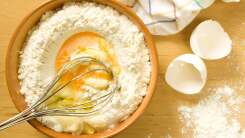Use More White Balsamic Vinegar
You’re probably familiar with balsamic vinegar—that sophisticated, inky bottle coyly sitting in the corner of your kitchen under a light coat of dust. We know it for its dramatic, deeply caramelized flavor, but balsamic vinegar has a lesser-known, easy-going sister: Not talked about nearly enough and confined to a smaller footprint on the grocery store shelf is white balsamic vinegar. And she’d like your attention, please.
Growing up, I first learned about balsamic vinegar by watching Emeril Lagasse cook on TV, and only in real life as that splash of black liquid lava-lamping in the oil bowls of Jersey-Italian restaurants. Other than dipping bread and occasionally reducing it into a potent, syrupy drizzle, I rarely used it. To be honest, even as an adult I don’t love the flavor much. It can easily overpower dishes, and the color stains or mutes bright fruits or salads.
I had long given up on balsamic vinegar when I stumbled on an independent olive oil store called The Blue Olive. They had stainless steel decanters of olive oil that you could sample, and being who I am, I couldn’t resist. Surprisingly, I found an entire wall of white balsamic vinegars. Maybe I’m being dramatic, but I was speechless for at least five and a half seconds before I procedurally tried as many as I could. I tasted something around 12 palate-tingling, white balsamics before my tastebuds quit on me. They were fresh, tart, and juicy without actually being juicy. Why aren’t people talking about this stuff more?

How white balsamic vinegar is made
While traditional dark balsamics are aged in wooden barrels for at least 12 years, white balsamics age for less time (usually a maximum of 12 years). Dark balsamics are cooked in a kettle to achieve their caramel flavor and subsequently aged in old barrels that have been fired on the inside; white balsamic gets pressure cooked and is aged in new wooden barrels. Dark balsamic reveals itself as a powerful, stinging, moody, dark, and woodsy condiment, and white balsamic is the yang–bright, tangy, crisp, subtle, and sweet with a clean finish.
How to cook with white balsamic vinegar
If you’re looking for more interesting ways to add a light little snap to your dishes, give white balsamic vinegar a try. I love to use white balsamics as a finishing condiment to bring in a splash of balancing acidity. It’s great in salad dressings, you get the complexity of dark balsamic without the muddy discoloration, and it’s more mellow than apple cider vinegar. Try it in marinades, or splash it over ripe fruit (I’m partial to this grapefruit one with strawberries). White balsamics make a lovely pan sauce, too. To do it, use a splash of vinegar to deglaze the pan that you used for chicken, fish, or scallops, reduce to the desired consistency, and drizzle over the awaiting morsels.
RECOMMENDED NEWS

Harness the Awesome Power of Your Air Fryer This Thanksgiving
By this point, pretty much everyone is aware that air fryers are “just small convection ovens” and t...

The 7 Deadly Sins of Baking
Who among us has not binge-watched The Great British Bake Off and thought, “I could do that, easy!” ...

Thicken Your Pan Sauce With Sour Cream
I take a pretty minimal approach to pan sauces, especially on weeknights. I take the meat out of the...

Fight the Winter Doldrums With These Fruity Pickles
Pickling is an ancient art of preservation. Without it, many of our ancestors would’ve died of starv...

Make Fucked Up Cinnamon Toast With Apple Brandy Butter
When I first read the words “vodka butter,” I was distraught. I could not think of a single reason t...

11 Compound Butters That Will Get You Out of a Butter Rut
I cannot function without butter. I keep at least two types on hand at all times—one for cooking and...
Comments on "Use More White Balsamic Vinegar" :